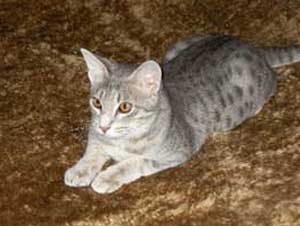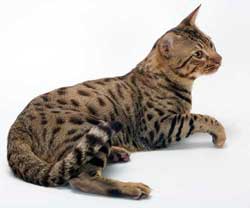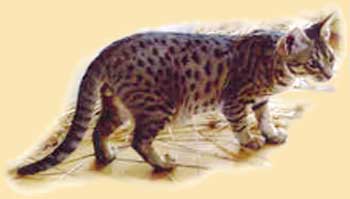The Official source of the Ocicat Club |
WELFARE If you know of an Ocicat welfare issue, or an adult Ocicat needing a new home...
Read more>
|
The Ocicat
Nothing is more awe inspiring than a beautiful wild cat manifesting
feline grace, power and athleticism, and when it is spotted this adds a special dimension to its beauty. Their spots and “wild look” distinguish the all domestic Ocicats from all other domestic cats as does their loving temperament and high intelligence.
History
The Ocicat is a beautiful spotted domestic cat which has been
selectively bred to emulate and encapsulate the natural cat of the wild.
It has all of their virtues and none of their drawbacks. The first
Ocicat occurred by accident in the USA in 1964 when Mrs Virginia Daly
attempted to obtain an "Aby pointed" Siamese. However she found, in
a second generation Abyssinian - Siamese Cross, a beautiful golden
spotted male kitten. Her daughter remarked on the resemblance to a baby
Ocelot and asked "Why don’t we call him an Ocicat?". Tonga,
as he was called, ushered in the new breed into the world.
"The Ocicat is a beautiful spotted domestic cat"
Tonga himself was never used for breeding, but a subsequent mating
produced his brother, a Tawny coloured Ocicat who started the breeding
programme. The next step was the introduction of the American Short Hair
which contributed body substance and the silver colour gene. It took
over 20 years for official recognition of the breed in America but it
came in 1986 and since then the Ocicats have become one of the most
popular breeds in the States. Out crossing to the Abyssinian is still
permitted, as it is in the UK, a valuable means of adding to the gene pool.
"The Ocicat offers the beauty of a wild cat yet it
retains the wonderfully predictable disposition of the domestic cat"
The beautiful appearance and wonderful coats of Ocelots, Leopards and
Jaguars have captivated feline enthusiasts for centuries but never
before has there been a successful attempt to breed an entirely new
domestic cat. Ocicats offer the beauty of wild cats yet retain the wonderfully predictable disposition of domestic cats.
The exotic look of the Ocicat belies its affectionate personality and
temperament, and there are no wild genes whatsoever used in Ocicat
bloodlines.
The body, head and spotted coat should be similar in appearance to
that of a wild cat and the Ocicat moves in a natural fluid manner,
often keeping low to the ground as if stalking his prey. The Ocicat has
a well-muscled, long body with an equally, proportioned long tail.
Many owners remark on the dog-like tendencies of the breed, in that
they are devoted to people, are easily trained and respond well to the
voice, while retaining their feline independence. Because of their adaptability they are a joy to be with, they are
not demanding in any way and seem to take life in their stride. They are
confident with children and quite extrovert in their own idiosyncratic
way. Ocicats are reasonably vocal and do not like being left alone for
long periods, but do make ideal companions for households with other
pets.
Although known as an exotic breed, Ocicats require no special care
and are particularly healthy, the broad genetic background giving them a
robust vigour and vitality.
Ocicat Standard of Points
| General |
The Ocicat is a medium to large well-spotted agouti cat of moderate type, noted for its “wild” appearance. It is athletic and powerful, yet graceful and lithe. The spots are well scattered in a distinctive pattern on the sides of the body across the shoulders and hindquarters and extending down the legs, with a well spotted belly. The head accentuates the wild appearance, with moderately large ears and large expressive almond shaped eyes. The body is solid, rather long, with a well-muscled chest and substantial muscle and bone development surprising in this elegant cat. The tail is fairly long, not whippy; the coat is sleek and close lying. The Ocicat’s temperament belies its wild appearance, though active, intelligent and demanding of attention, its agreeable nature makes it an ideal companion to man and beast. |
| Head |
Modified wedge, longer than it is wide, showing a slight curve from muzzle to cheek, with a visible but gentle rise from the bridge of the nose to the brow. There is no nose break as such, but a slight dip is seen in profile. The muzzle is broad and well defined with a definite suggestion of squareness and in profile shows good length. Strong chin. Firm jaw. Broad, level bite. Moderate whisker pinch. Head carried gracefully on an arching neck. Allowance should be made for jowls on mature males. |
| Ears |
Alert, moderately large and wide at base, set at a 45 degree angle, neither too high nor too low, with at least the width of an ear base between them. The tips of the ears should be gently rounded; vertical tufts from the ear tips are desirable but not essential. |
| Eyes |
Large, full almond shaped, and angled slightly upwards towards the ears, more than the length of an eye between the eyes. All eye colours except blue are allowed, with no correspondence between eye colour and coat colour. Depth of colour preferred. |
| Body |
Solid, with substantial bone and muscle development and an athletic appearance. The body should be long. The chest should be deep and rather broad but never coarse. The back should be straight and slightly higher at the rear. Both sexes should feel surprisingly heavy for their size, with the females smaller than the males. |
| Legs & Feet |
Legs of good substance and well muscled. Medium length, powerful and in good proportion to the body. Paws oval paws and compact. |
| Tail |
Fairly long and in good proportion to the body, broad at base with only a slight taper, no whip |
| Coat |
Short, satiny in texture with a lustrous sheen. Close lying and sleek, with no suggestion of woolliness. Allowances should be made for seasonal variation. |
| Colours |
All colours should be clear and pleasing and the spotting should not be faint or blurred, although the pale colours will show less contrast than the darker ones. The lightest colour is found on the face, chin, lower jaw and abdomen. The darkest colour is found on the tip of the tail and the tail tip colour is the final definitive in determining the colour of the cat. Each hair (except on the extremities) has several bands of colour, and where the dark bands fall together a spot is formed on the surface of the coat. |
| Pattern |
The eyes should be rimmed with the darkest coat colour and surrounded by the lightest colour, giving a “mascara” effect. There should be dark markings on the cheeks and an intricate tabby “M” on the forehead, with markings extending up over the head between the ears and breaking into small spots on the lower neck and shoulders, and rows of spots along the spine from shoulder blades to tail. The tail should have rings of darker colour, ideally alternating with spots, and must have a dark tip. There should be scattered spots across the shoulders and hindquarters, extending as far as possible down the legs with broken bracelets on the lower legs and often broken necklaces at the throat. There should be larger, well scattered thumb print shaped spots on the sides of the body, forming a “bull’s eye” pattern of a spot circled by spots. The belly should be well spotted. Dark markings should be found at the backs of the hind legs. Well defined spots contrasting strongly with the background colour are much more important than exceptionally large spots: but allowance must always be made for the contrast in dilutes and pale silver varieties. Heavy tarnishing in Black Silvers is undesirable. |
Colours
For images of the 12 Ocicat colours please click here
There is a degree of variation in each of the colours
| Tawny |
Black or dark brown spotting on a tawny agouti ground. Nose leather brick red rimmed with black. Paw pads black or
dark brown. Eye rims black. Tail tip black.
|
| Chocolate |
Chocolate spotting on a pale copper agouti ground. Nose leather pink rimmed with chocolate. Paw pads chocolate, chocolate-pink. Eye rims chocolate. Tail tip dark chocolate. |
| Cinnamon |
Bright cinnamon spotting on a lighter cinnamon agouti ground. Nose leather pink rimmed with cinnamon. Paw pads
pink. Eye rims cinnamon. Tail tip cinnamon.
|
| Blue |
Blue spotting on a mushroom or pale blue agouti ground. Nose leather pink rimmed with dark blue. Paw pads blue. Eye rims blue. Tail tip blue. |
| Lilac |
Lilac spotting on a pale oatmeal or dove-grey agouti ground. Nose leather pink rimmed with dark lilac. Paw pads lilac-pink. Eye rims lilac. Tail tip lilac. |
| Fawn |
Fawn spotting on a pale oatmeal agouti ground. Nose leather pink rimmed with fawn. Paw pads pink. Eye rims fawn. Tail tip fawn. |
| Black Silver |
Black spotting on a silvery-white ground. Nose leather brick red rimmed with black. Paw pads black. Eye rims black. Tail tip black. |
| Chocolate Silver |
Chocolate spotting on a creamy-silver ground. Nose leather pink rimmed with chocolate. Paw pads chocolate-pink. Eye rims chocolate. Tail tip chocolate. |
| Cinnamon Silver |
Cinnamon spotting on a cinnamon-silver ground. Nose leather pink rimmed with cinnamon. Paw pads pink. Eye rims cinnamon. Tail tip cinnamon. |
| Blue Silver |
Blue spotting on a blue-silver or mushroom silver ground. Nose leather pink rimmed with blue. Paw pads pink. Eye rims blue. Tail tip blue |
| Lilac silver |
Lilac spotting on a lilac-silver ground. Nose leather pink rimmed with dark lilac. Paw pads lilac-pink. Eye rims lilac. Tail tip lilac. |
| Fawn Silver |
Fawn spotting on a fawn-silver ground. Nose leather pink rimmed with fawn. Paw pads pink. Eye rims fawn. Tail tip fawn.
|
Scale of Points
| Head |
5 |
| Muzzle |
10 |
| Ears |
5 |
| Eyes |
5 |
| Body |
10 |
| Size & Weight |
5 |
| Legs & Feet |
5 |
| Tail |
5 |
| Pattern |
25 |
| Colour |
10 |
| Contrast |
10 |
| Texture |
5 |
Withhold All Awards For:
- White locket or spotting, or white anywhere other than around eyes, nostrils, lips, chin and upper throat (except white agouti ground in silver colours).
- Blue eyes.
- Reds, creams or tortoiseshells.
- Cats with very indistinct spotting.
Withhold Certificates and First Prizes in Open and Kitten Classes
for:
- Oriental or British head.
- Oriental or British body type.
- Long, shaggy or rough coat.
- Small boned, fragile appearing animals.
- Whiptail.
- Any defect as listed in the preface to the GCCF SOP booklet
Faults
- Round or protruding eyes.
- Close-set or upright ears.
- Straight profile.
- Pointed muzzle.
Ocicat Breed Numbers and Colours
| OCI n |
Tawny |
| OCI a |
Blue |
| OCI b |
Chocolate |
| OCI c |
Lilac |
| OCI o |
Cinnamon |
| OCI p |
Fawn |
| OCI ns |
Silver |
| OCI as |
Blue Silver |
| OCI bs |
Chocolate Silver |
| OCI cs |
Lilac Silver |
| OCI os |
Cinnamon Silver |
| OCI ps |
Fawn Silver |

|
| Blue Ocicat |
|


